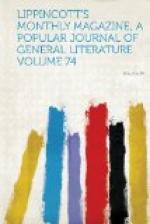“Dusty,” did we say? The ceaseless sob of engines that rob the Schuylkill daily of six millions of gallons to sprinkle over asphaltum, gravel and greensward demands recantation of the word. Everything has been foreseen and considered, even the dust of the earth. George’s Hill Reservoir can, on occasion, give the pumps several days’ holiday, and keep all fresh and dewy as the dawn.
Some industries meet us in the Centennial list that are not to be detected in the United States census or any other return we are acquainted with. What train of ideas, for example, is suggested to the average reader by the Roll-Chair Company? The rolling-stock of this association turns out, on inquiry, to be an in-door variety of the conveyance wherein Mrs. Skewton was wont to take the air under the escort of Major Bagstock. It is meant for the relief of those who wish to see everything in the Main Building without trudging eleven miles. Given an effective and economical motive-power, the roll-chair system would seem to meet this want. The reader of Dombey and Son will recollect the pictorial effect, in print and etching, of the popping up of the head of the propellent force when Mrs. S. called a halt, and its sudden disappearance on her directing a resumption of movement. The bobbing up and down of four hundred and fifty heads, like so many seals, will impart a unique aspect to the vista from one of the interior galleries of the great hall. The stipulated tax of forty dollars on each of these vehicles will necessitate a tolerably active undulation of polls if the company is to make both ends meet—granting that a rotatory movement can have an end.
Another startling item is the pop-corn privilege. A business-man of Dayton, Ohio, finds himself justified in venturing the heavy sum of seven thousand dollars on this very light article. Parched corn was well known in Ohio in 1776. The Miamis and Shawnees had, however, a monopoly of it. It composed their commissariat for a campaign against the whites. Such is the progress of the century.
This explosive cereal does not satiate the proverbially sweet tooth of our people. Their craving for confectionery is laid under further contribution by the financial managers of the exposition to the tune, for instance, of five thousand dollars for the privilege of manufacturing chocolate and candy. Dyspepsia insists on asserting its position among the other acquisitions of the century. The treasures of the American bonbonniere are said to be richer and more varied than in any other country. Paris gets up her delicacies of this kind in more tasteful and tempting style, but our consumers care little for such superficial vanities. They look for solid qualities in everything—even in their lollipops.




